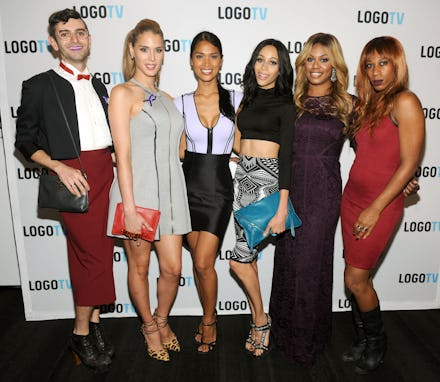One Striking Map Captures the Biggest Issue Facing Transgender People in America

There's no denying that the transgender community has made major strides lately in pursuit of mainstream acceptance. Pop culture has helped — Laverne Cox, star of Netflix's Orange is the New Black and a trans rights activist, recently landed on the cover of TIME Magazine accompanied by the headline "The Transgender Tipping Point." High-fashion model Andreja Pejic came out publicly as a transgender woman in July, and in February, former People magazine editor Janet Mock wrote a memoir about her trans experience. It made the New York Times best-seller list.
Yet this forward motion — while in many ways momentous — isn't the end of the story. Transgender people still face enormous discrimination, and it comes from plenty of sources. It's both institutional and cultural, and it's often worse than injustices faced by other groups, including gay, lesbian and bisexual people.
To that end, Maddie Taterka created the following map for Autostraddle:
Its message is clear. Members of the trans community face social and cultural discrimination at every turn, far beyond legal barriers. As Taterka writes, legal rights "[don't] consider the many other barriers trans people face. These barriers cannot be resolved with laws and legal rights, but they need to be broken down in order for trans people to fully exercise those rights."
In other words, the fight for equality goes beyond the law. It also requires a shift in societal attitudes because the battles waged in America's dining rooms are just as important as the ones waged in its courtrooms.
Let's look at the courtrooms first for good measure. Taterka's map is a response to a story featured on the website Vocativ. The authors of that story, Luke Malone and EJ Fox, correctly point out that trans people still face enormous legal barriers to equality. Their maps touch on five areas: hate crimes, healthcare, employment, schools and identity documents.
However, Taterka's point is well taken: Legal battles are just one frontier. They may be the most visible and the most tangible, but deep-seated change — the one that must come from families and communities and attitudes — will ultimately prove to be the real test. And as Taterka illustrates, we've still got a ways to go.
The numbers: According to a 2007 report by the Williams Institute on Sexual Orientation Law and Public Policy, which summarized the findings of various studies conducted on workplace discrimination, 20% to 57% of transgender respondents experience workplace inequality at some point in their life. (LGB respondents reported slightly lower numbers, coming in at 15% to 43%.)
The Williams Institute revisited the subject again in 2012 and found an even more staggering number: Up to 90% of respondents in biggest survey of transgender worker of the time said they experienced harassment or mistreatment at work.
Home life doesn't fare that well, either. According to a 2011 joint study by the National Center for Transgender Equality and the National Gay and Lesbian Task Force, 57% of transgender and gender non-conforming respondents reported "significant family rejection" over their gender identity.
The trans community within a broader context: As Tyler Curry points out in the Huffington Post, the trans community has taken a backseat to the gay and lesbian community in the public fight for equality:
In the beginning of the gay rights movement, the battle against violence, outright discrimination and blatant intolerance was one that gays, bisexuals and transgender men and women were equally invested in.
Gays and lesbians have achieved an enormous amount in terms of both mainstream acceptance and legal equality, and a majority of Americans now support marriage equality. The trans community, however, still lags behind.
"My sense is that we are 20 years behind the mainstream gay and lesbian movement in terms of public understanding," Michael Silverman, executive director of the Transgender Legal Defense and Education Fund, told the Associated Press. In the same piece, Mara Keisling, executive director of the National Center for Transgender Equality, stressed the importance of accessibility. The best way to propel acceptance of the trans community forward, she said, would be to let Americans become more familiar with transgender people.
"A huge number of Americans now have gay family members, gay coworkers ... but most of them don't know a transgender person, and that means we're ripe for scapegoating," she told the Associated Press.
So where do we go from here? As the gay rights movement has illustrated, mainstream societal acceptance and legal equality often go hand in hand. But by that same token, mainstream acknowledgement isn't automatic — it's a process, and it's constantly evolving.
The same is true of trans rights, and it's deftly illustrated in Tanerka's map. The trans community has recently made huge leaps — and that shouldn't be undersold — but there's a long, hard road ahead to mainstream acceptance.
And yet, as Cox told TIME, it's something that has begun in earnest.
"More of us are living visibly and pursuing our dreams visibly, so people can say, 'Oh yeah, I know someone who is trans,'" she said. "When people have points of reference that are humanizing, that demystifies difference."